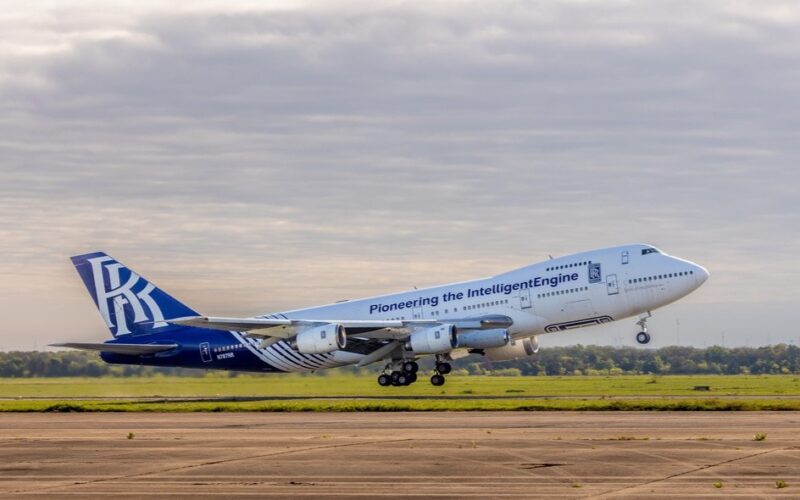Aerospace
Rolls-Royce Launches Test Flights for Revolutionary Pearl 10X Engine

Rolls-Royce reports that the company’s dedicated Boeing 747 flying testbed has seen the successful start of the Pearl 10X, their newest aero engine designed for the business aviation industry.
Dassault, a French aircraft manufacturer, has decided to use this engine only to power their newest flagship, the Falcon 10X. As stated at last year’s Capital Markets Day, the commencement of flight testing represents a significant milestone for both Rolls-Royce and the Pearl 10X programme as the company concentrates on expanding in the business aviation industry.
The first Rolls-Royce engine to power a Dassault business jet is the Pearl 10X, the newest engine in the state-of-the-art Pearl engine family. The Pearl 10X was chosen by the French aircraft manufacturer as their new flagship model, demonstrating even more of Rolls-Royce’s dominance in the business aviation engine market.
Over the next few months, pilots and flight test engineers from Tucson, Arizona, USA, will put the engine through its paces. The flight test programme will comprise testing of the nacelle’s anti-icing system, in-flight relights, engine performance and handling checks at various speeds and altitudes, and fan vibration tests at various altitudes.
The new auxiliary gearbox, which enables higher additional power extraction, and the ultra-low emissions ALM combustor, which is compatible with 100% Sustainable Aviation Fuel (SAF), have undergone extensive testing as part of the ground-based development programme thus far. The engine will be the most potent business aviation engine in the Rolls-Royce lineup. It exceeded its intended thrust levels during the very first test run. With over 2,300 testing hours successfully completed on the Pearl 10X engine configuration as well as the Advance 2 demonstration, the programme is moving forward at a rapid pace.
With the most economical engine core available for business aircraft, the Advance2 engine, coupled with a high-performance low-pressure system, gives the Pearl 10X an exceptional thrust of over 18,000 lbf. With a 5% increase in economy over the previous generation of Rolls-Royce commercial aviation engines, the Pearl 10X

Aerospace
Boeing Transfers Rocket Stage to NASA, Paving Way for Human Moon Mission

Boeing has achieved a significant milestone by providing NASA with the second core stage of the Space Launch System (SLS) rocket.
This crucial component, crafted at NASA’s Michoud Assembly Facility (MAF), is set to propel the Artemis II crew into lunar orbit, marking humanity’s return to deep space after a 50-year hiatus.
The monumental Boeing-built rocket stage, the largest element of the Artemis II mission, will embark on a journey aboard the Pegasus barge, traveling 900 miles to NASA’s Kennedy Space Center.
Comparison of two legendary aircraft B777x vs B747 aircraft:Click here
Upon arrival, it will be meticulously integrated with other essential Artemis II components, including the upper stage, solid rocket boosters, and NASA’s Orion spacecraft within the iconic Vehicle Assembly Building. This intricate integration process is a vital step toward the eagerly anticipated Artemis II launch, slated for 2025.
“Boeing-built products helped land humankind on the moon in 1969, and we’re proud to continue that legacy through the Artemis generation,” remarked Dave Dutcher, vice president and program manager for Boeing’s SLS program. “Together, with NASA and our industry partners and suppliers, we are building the world’s most capable rocket and paving the way to deep space through America’s rocket factory in New Orleans.”
NASA, Lockheed Martin Reveal X-59 Quiet Supersonic Aircraft:Click here
The delivery of Core Stage 2 marks a significant achievement in the evolution of the SLS rocket. Towering over 200 feet and powered by four RS-25 engines, this core stage, coupled with two solid-fueled booster rockets, will generate a staggering 8.8 million pounds of thrust. This immense power is crucial to launching Artemis II and future missions into the vast expanse of space.
The SLS rocket stands unparalleled in its capability to transport both crew and substantial cargo to the moon and beyond in a single launch. Its extraordinary capacity will facilitate the delivery of human-rated spacecraft, habitats, and scientific missions to destinations including the moon and Mars, ushering in a new era of space exploration.
-

 Travel1 week ago
Travel1 week agoAir India to Expand US Operations with Three New Routes After a Decade
-

 Travel2 weeks ago
Travel2 weeks agoWhy We Should Avoid These Stamps in a Passport
-

 Airlines1 month ago
Airlines1 month agoInvestigations Reveal Fake Chinese Titanium in Boeing and Airbus Jets
-

 Tech4 weeks ago
Tech4 weeks agoChina’s CATL Plans 1,800-Mile Electric Plane Launch by 2027
-

 Airport3 days ago
Airport3 days agoTop 10 Largest Airports in the World by Size
-

 Aerospace4 weeks ago
Aerospace4 weeks agoChina’s Fighter Jets Turn Wings into Autonomous Drones
-

 Airlines4 days ago
Airlines4 days agoAir India Rolls Out A350s for Delhi-New York JFK and Newark Routes
-

 Defence3 weeks ago
Defence3 weeks agoBoeing Enhances Chinook with New Engines and Block II Upgrades at $96 Million







